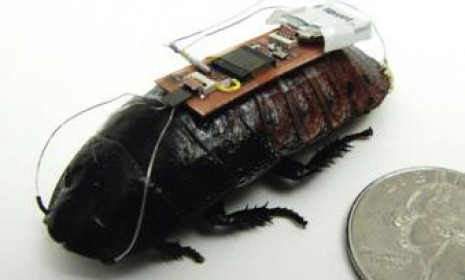Cockroaches controlled by remote control: A search-and-rescue breakthrough?
Researchers have discovered a way to steer living, breathing bugs using a cheap circuit they can glue onto the pests' backs

Robots inspired by the animal kingdom are nothing new. But what about tiny creatures bio-engineered to become, essentially, machines? That's the weird premise behind a new experiment from researchers at North Carolina State University (NCSU), who have found a way to control the movements of living, breathing cockroaches using a joystick — much the way you steer a remote-control car. Here's what you should know:
Why turn cockroaches into remote-control cyborgs?
The thinking is that a smart network of digitally enhanced bugs equipped with miniature cameras can quickly comb through disaster areas (like a collapsed building) to search for survivors without putting the lives of rescuers at risk. Tiny robots were also considered for the task, but building them proved too complex. "It is certainly easier and more cost-effective to control a cockroach than to build a miniature robot from scratch," says Isaac Leung at Electronic News. Enter the remote-control cockroaches, which aren't even the first insects to be manipulated by implanted electronics; the NCSU team has already done the same with hawk moths to control the speed and direction of their flight.
The Week
Escape your echo chamber. Get the facts behind the news, plus analysis from multiple perspectives.

Sign up for The Week's Free Newsletters
From our morning news briefing to a weekly Good News Newsletter, get the best of The Week delivered directly to your inbox.
From our morning news briefing to a weekly Good News Newsletter, get the best of The Week delivered directly to your inbox.
What exactly did the researchers do?
The team glued a small wireless electronic "backpack" onto one of the largest flightless bugs they could find: The Madagascar hissing cockroach. They discovered that by hooking up electrodes to its antennae and cerci — "sensory organs on the abdomen that are normally used to detect the approach of a predator," says Duncan Geere at Wired — they could control the way it crawls.
How does the system work?
By stimulating the cerci, the scientists were able to fool the roaches into "thinking something was sneaking up behind them," causing them to scurry forward, says Geere. To steer them, researchers sent electrical signals to the bugs' antennae. This fooled the cockroaches into thinking they were touching a surface, causing them to turn in the opposite direction.
A free daily email with the biggest news stories of the day – and the best features from TheWeek.com
How did the bug perform in tests?
In trials, researchers were were able to "precisely control the movements of the insects along curvy lines," says Electronic News' Leung. (Watch a demonstration below.) In extended tests, however, the weight of the controllers seemed to hamper the cockroaches' progress, says The Register. The next step is to make the attachable units a little more lightweight.
Sources: Electronic News, The Register, Slate, Wired
-
 Trump vs. states: Who gets to regulate AI?
Trump vs. states: Who gets to regulate AI?Feature Trump launched a task force to challenge state laws on artificial intelligence, but regulation of the technology is under unclear jurisdiction
-
 Decking the halls
Decking the hallsFeature Americans’ love of holiday decorations has turned Christmas from a humble affair to a sparkly spectacle.
-
 Whiskey tariffs cause major problems for American distillers
Whiskey tariffs cause major problems for American distillersIn the Spotlight Jim Beam is the latest brand to feel the pain